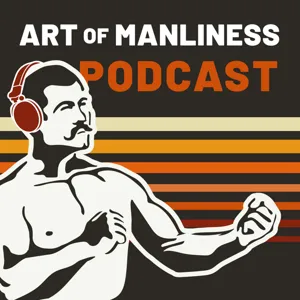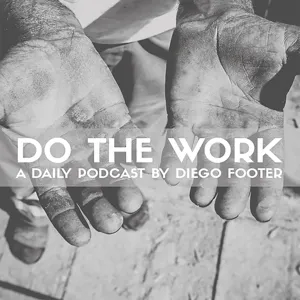Podcast Summary
Scheduling tasks with specific start and end times for completion: Timeboxing adds a fourth dimension to traditional time blocking by focusing on completion and moving on to the next task, providing a sense of reassurance and better time management.
Timeboxing is a productivity method that helps you live a more intentional life by scheduling your to-dos on your calendar with specific start and end times, ensuring you complete each task within that timeframe. This system, as explained by Mark Zau Sanders, author of "Time Boxing," adds a fourth dimension to traditional time blocking by focusing on completion and moving on to the next task. By knowing exactly what you're supposed to be doing at any given moment, timeboxing provides a sense of reassurance and helps you make better use of your time. It's a simple yet effective method for managing your day and increasing your overall productivity.
Discovering the power of time boxing for productivity: Time boxing helps prioritize tasks, focus, and reduce stress by dedicating specific time frames to work on important tasks, while limiting distractions.
Time boxing is a time management technique that helps individuals use their time better by dedicating specific time frames to tasks, as opposed to the traditional to-do list or calendar system. The speaker, who discovered time boxing in 2013 after struggling with productivity issues for years, found that it effectively solved the problem of feeling overwhelmed and stressed in modern life, which is often caused by the abundance of choices and distractions. Time boxing is consistent with other time management techniques, such as the Pomodoro Technique, but it stands out by providing a simple yet effective way to decide what's most important and focus on it, without letting distractions take over. The speaker's experience with time boxing led him to write an article for Harvard Business Review in 2018, which gained significant popularity and eventually led to the writing of a book on the topic.
Manage tasks with Timeboxing and other techniques: Timeboxing helps prioritize tasks, break them down, and schedule specific time slots for completion, increasing productivity and reducing stress.
Timeboxing is a flexible time management technique that can be used in conjunction with various other methods, such as the Pomodoro Technique, Eat That Frog, and the Eisenhower Matrix. It allows individuals to prioritize tasks, break down larger tasks into smaller, actionable ones, and schedule specific time slots for completing them. By doing so, it brings a sense of concreteness to one's day and helps alleviate stress from having open loops and unfinished tasks. Timeboxing is a powerful tool for managing knowledge work and increasing productivity.
Structuring your day with Time Boxing: Time Boxing helps increase productivity by structuring your day into specific time slots, reducing distractions, enhancing mental clarity, and promoting a sense of calm and freedom.
Time Boxing is a productivity method that helps individuals focus on one task at a time by structuring their day into specific time slots. By doing so, it reduces distractions, enhances mental clarity, and promotes a sense of calm and freedom. Time Boxing also encourages implementation intentions, which are statements of when a situation arises, one will perform a specific response. This method brings discipline and structure to one's day, leading to increased productivity and overall sense of accomplishment. It's a simple yet effective way to manage tasks and prioritize one's time, ultimately leading to a more intentional and focused life.
Using implementation intentions and timeboxing for increased productivity: Implementing specific plans and commitments (implementation intentions) and scheduling tasks (timeboxing) can significantly boost the likelihood of completing activities by up to 90%.
Making specific plans and commitments, known as implementation intentions, can significantly increase the likelihood of following through on desired actions. According to studies, using implementation intentions, such as timeboxing, can increase the chances of completing an activity by up to 90%, compared to just having a vague intention or motivation. Timeboxing involves scheduling specific times for tasks in your calendar and setting reminders, creating a strong commitment and accountability. It's not just about managing work tasks, but also self-improvement activities like exercise, meditation, or learning. When unexpected free time arises, using a mnemonic like "Mr. Elf" (meditation, reading, exercise, learning, and friends or family) can help fill the time with healthy and productive activities. Overall, the science behind implementation intentions and timeboxing provides a strong foundation for effective time management and goal achievement.
Maximize productivity and improve organization with time boxing: Time boxing helps prioritize tasks, reduce distractions, keep records, and facilitate collaboration by breaking down your day into manageable time blocks
Time boxing is an effective productivity tool that not only helps you get more done but also ensures you focus on the right things. By breaking down your day into manageable time blocks, you can prioritize tasks, reduce distractions, and make the most of your time. Additionally, time boxing serves as a valuable record-keeping tool, providing an objective and comprehensive log of your activities. This can be particularly useful for remembering important events, giving you a more detailed and accessible memory of your life. Furthermore, time boxing can facilitate better collaboration by helping team members coordinate schedules and deadlines. Overall, time boxing is a simple yet powerful technique for maximizing productivity and improving the organization of your personal or professional life.
Sharing digital calendars for better time management: Sharing digital calendars can increase efficiency, deepen relationships, and reduce friction by allowing others to see availability and adjust plans accordingly. Trust is key for success, leading to a harmonious work environment.
Using a shared digital calendar for time management can lead to increased efficiency, deeper relationships, and reduced friction in interpersonal commitments. By making your schedule transparent, you allow others to see when you're available and can adjust their own plans accordingly. Trust is essential for this system to work effectively, but it can lead to a more harmonious work environment by eliminating unnecessary commitments and reducing the need for constant communication. A digital calendar is recommended due to its versatility, accessibility, and collaborative features. The use of a single list to capture tasks, such as a Google Doc, is also suggested for effective time boxing.
Consistent system for tasks and scheduling: Use a tool to store and access all tasks and notes. Timebox tasks with set deadlines or timeframes to maximize productivity and focus on priorities.
Having a consistent system for capturing tasks and scheduling them is crucial for effective time management. The speaker uses a Google Doc for their to-do list and meeting notes, but the specific tool doesn't matter. The key is having one place where everything is stored and easily accessible. The calendar is another essential tool for managing time, as it helps ensure that appointments and deadlines aren't missed. To determine which tasks can be timeboxed, or scheduled for specific time blocks, it's important to consider anything that needs to be done and can be completed within a set timeframe. Examples include daily exercise, meetings preparation, and even meetings themselves. By timeboxing these tasks, one can ensure that they are making the most of their time and staying focused on their priorities. Overall, having a clear and consistent system for managing tasks and time is essential for productivity and reducing mental clutter.
Setting realistic time boxes for tasks: Effectively manage time by setting time boxes based on past experience, using consistent increments, and adjusting as needed to avoid decision fatigue and the planning fallacy.
Effective time management involves setting realistic time boxes for tasks based on past experience. Time boxing is a method of breaking down your day into manageable chunks, and having a consistent set of time increments (such as 15, 30, and 60 minutes) can help avoid decision fatigue. However, the planning fallacy, where we underestimate or overestimate the time required for a task, can lead to inaccurate time estimates. To overcome this, it's important to have experience with the task and adjust time boxes accordingly. For instance, some tasks, like meditation or a scheduled meeting, have a fixed duration and require no estimation. But for more complex tasks, setting a time box based on past experience is crucial for productivity and minimizing stress.
Effective Time Management through Time Boxing: Estimate tasks, set time limits, consider task order, and adjust as needed for productive time management.
Effective time management through time boxing involves carefully estimating tasks, setting realistic time limits, and being flexible when necessary. It's important to consider the order of tasks based on their dependencies and personal energy levels. When faced with a task that may take longer than expected, use midway checkpoints and make a judgment call based on the task's importance and the next scheduled activity. By being thoughtful about time boxing and adjusting as needed, individuals can maximize productivity and minimize the impact of the planning fallacy.
Effective Timeboxing and Unexpected Interruptions: Be flexible and prioritize tasks based on productivity and creativity when unexpected matters arise. Adjust time boxes as needed, but maintain realistic goals and schedule flexibility to minimize stress and maintain focus.
Planning your day effectively through time boxing can help increase productivity and enjoyment, but unexpected matters may arise and require adjustments. It's essential to be flexible and prioritize tasks based on personal productivity and creativity. When unforeseen circumstances occur, assess their urgency and importance before deviating from the plan. Most of the time, these interruptions are infrequent, and adjusting time boxes is an effective solution. Realistic goals and schedule flexibility are crucial when implementing timeboxing. Additionally, acknowledging that interruptions are inevitable and accepting that not every day will go according to plan can help reduce stress and maintain focus.
Manage Urgent Requests with Timeboxing: Set aside specific times to check and respond to emails or messages to reduce interruptions and improve focus and productivity.
We often receive seemingly urgent requests or notifications that disrupt our focus and productivity. These can come in the form of emails, texts, or phone calls. However, many of these requests are not as urgent as they seem and can wait. To avoid being constantly bothered by these apparent urgencies, the speaker suggests timeboxing – setting specific times to check and respond to emails or messages. This can help protect your time and focus, allowing you to be more productive and in control. When you do find yourself getting distracted from your timeboxed tasks, notice the feeling and associate it with a controlled response, such as coming back to your task or calendar appointment. With practice, this association will become stronger, making it easier to stay focused and avoid getting sidetracked. To get started with timeboxing, set a regular calendar appointment for checking and responding to emails or messages, and stick to it. This could be once or twice a day, or at other intervals that work for you. By setting aside specific times for handling these requests, you can reduce interruptions and improve your focus and productivity.
Practice time boxing for effective time management: Set aside specific time slots for focused work on priorities, start with a few tasks, increase productivity and feeling of accomplishment.
Effective time management can be achieved through the practice of time boxing. This means setting aside specific time slots in your day for focused work on your priorities. Mark Zao Sanders, the author of "Time Boxing," suggests starting with just two or three items from your to-do list and scheduling them in the morning. By dedicating time to these tasks, you'll increase the likelihood of getting them done and feeling productive. To implement this strategy, set a calendar appointment for yourself now to start timeboxing tomorrow. For more information on time boxing and to sign up for Mark's newsletter, visit his website at markzaussanders.com. Remember, don't just listen to this podcast, put the ideas into action to improve your time management skills.












